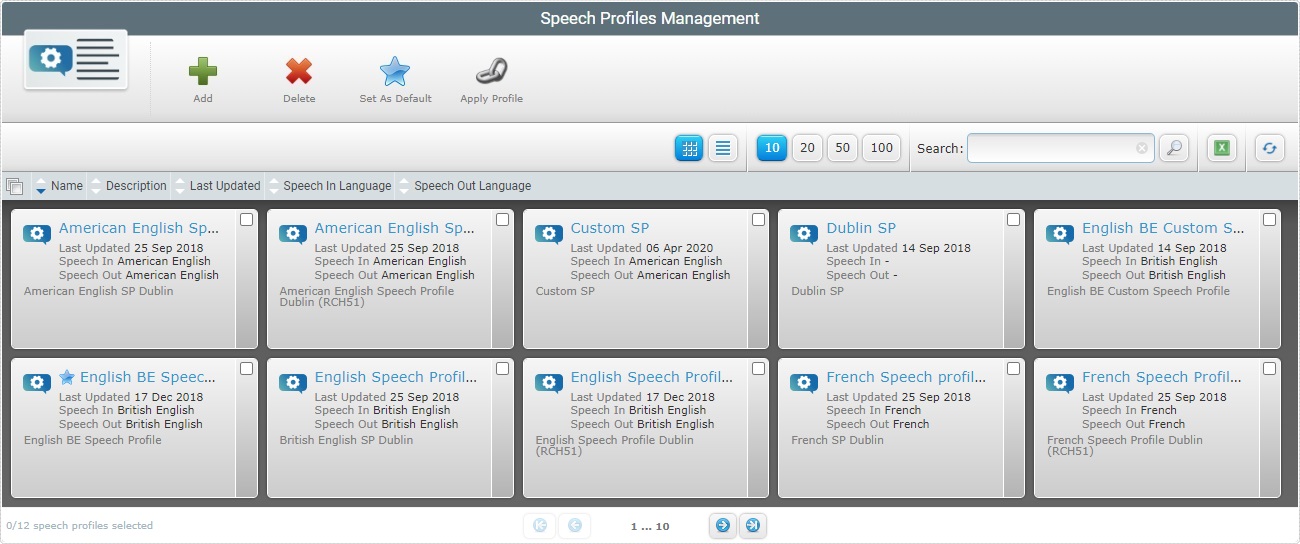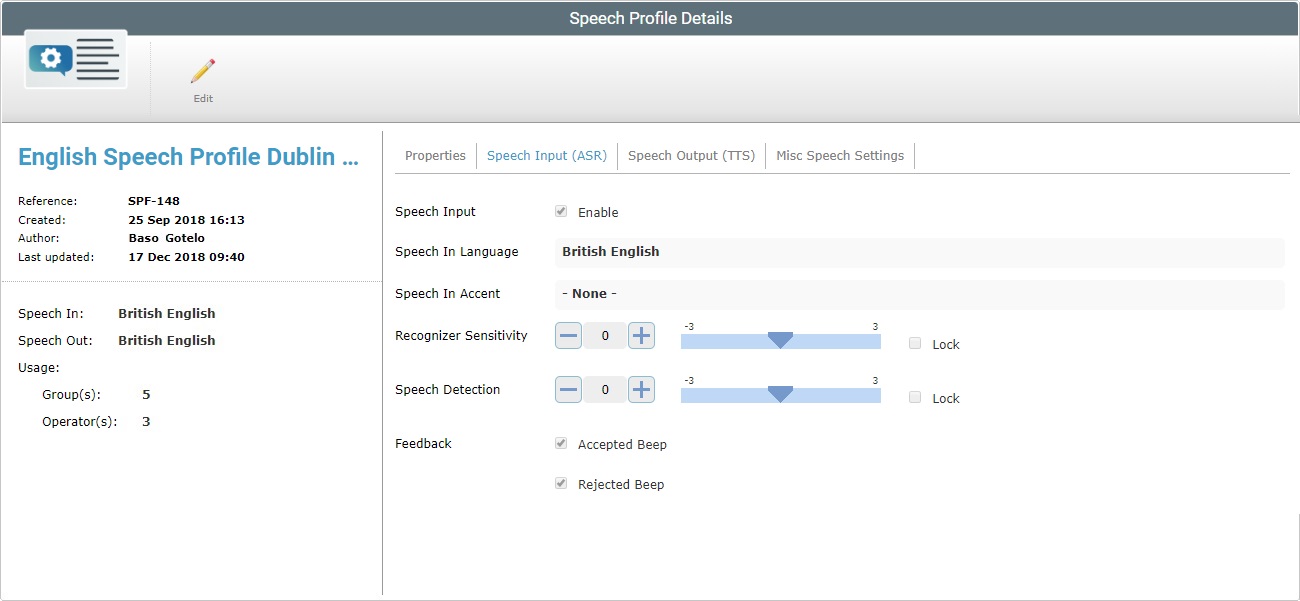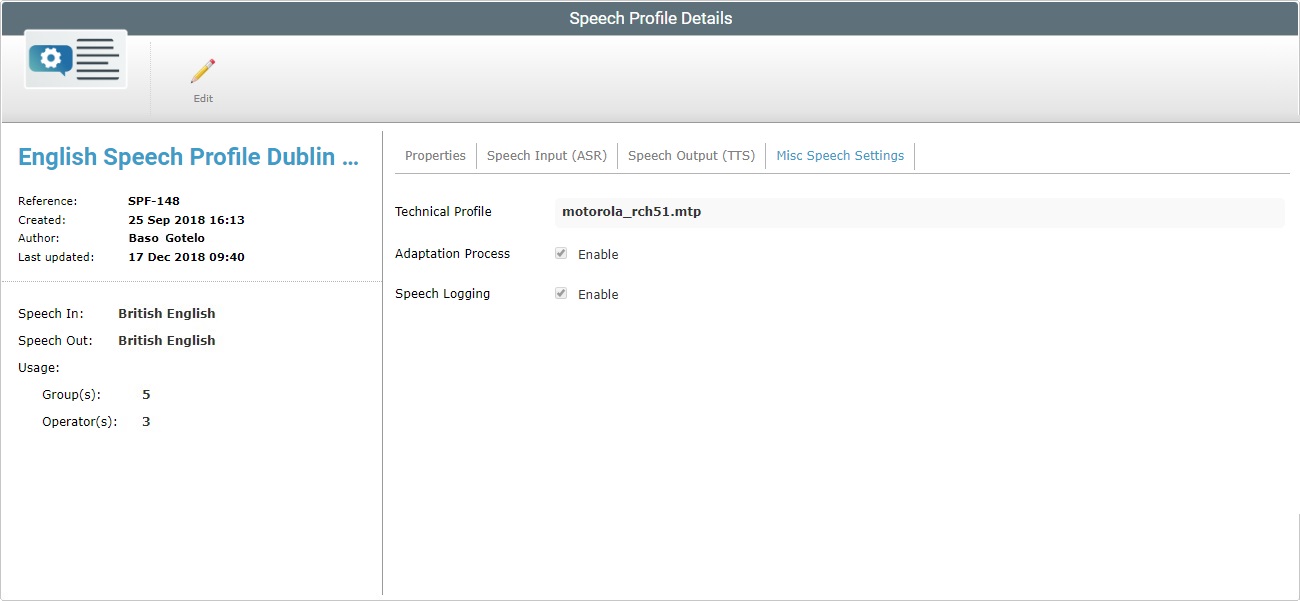Local Speech Profile Details
Overview
A Speech Profile consists of specific speech settings to be applied when using Speech applications. The designation Local Speech Profile refers to the fact that this is a speech profile created at site level and, therefore, can only be used within the site it is created in.
The "Speech Profile Details" page displays information concerning the selected local speech profile.
Click  (in the "Control Panel") and, in the resulting row below, select
(in the "Control Panel") and, in the resulting row below, select  to open the "Speech Profiles Management" page.
to open the "Speech Profiles Management" page.

Click the name of the speech profile (displayed in light blue) to view the corresponding details.
This page consists of a "Properties" tab, a "Speech Input (ASR)" tab, a "Speech Output (TTS)" tab, a "Misc Speech Settings" tab and a left panel.

The "Properties" tab is open by default and displays the following information:
Name |
The speech profile's name. |
Description |
Information regarding the speech profile. The added notes are displayed in the "Speech Profiles Management" page (in the corresponding "Description" field/column). |

The "Speech Input (ASR)" tab displays the following information:
Speech Input |
If checked, it means that the selected speech profile includes an input language. As a result, "speech input" related parameters are active/visible. If unchecked, it means that this setting is not enabled for the selected speech profile. As a result, there are NO "input speech" related options available/visible. |
||||||||||||||||||
Speech In Language |
Only available if the "speech input" setting is enabled. The language used by the operator to interact with the speech application (input language). |
||||||||||||||||||
Speech In Accent |
Only available if the "speech input" setting is enabled.The accent file that stores the fine tuning of speech recognition (speech transcriptions for the original spoken word).
|
||||||||||||||||||
Recognizer Sensitivity |
Only available if the "speech input" setting is enabled. This parameter defines the general acceptance balance regarding recognized words. Its purpose is to match the operator's speech to the expected words. (Available values from -3 to +3). When setting the recognizer sensitivity value, you must take the operator's speech level into account: •a good speech -high energy/loud and clear word pronunciation. •a poor speech -low energy and bad word pronunciation. Also, consider the operator's environment and if the resulting background noise level can interfere with word recognition. Ex: Too low recognizer sensitivity dismisses background noise but does NOT accept an operator's "poor" speech.
Possible settings based on general considerations:
Fine tuning suggestions:
|
||||||||||||||||||
Speech Detection |
(Aka Microphone Sensitivity) Only available if the "speech input" setting is enabled. It defines the "Speech Detection" levels that will "isolate" background noise from actual speech based on the received energy level. (Available values from -3 to +3). A high speech sensitivity helps detect a low energy speech (operator with a soft voice) but it increases the risk of noise processing. A low speech sensitivity reduces the risk of noise processing but requires a high energy speech (operator must speak loud and clear) for a good detection.
For operators with a loud and clear voice, define a speech sensitivity value of -1 or -2.
Note that some words start with low energy (ex: words with an initial "sh" sound) which means they might not be detected if the speech sensitivity value is too low. |
||||||||||||||||||
Lock |
Only available if the "speech input" setting is enabled. The values set in the "Recognizer Sensitivity" and "Speech Detection" options can be locked, meaning, they will not be available in an "Operator Profile Details" page for editing. The checked option(s) will be hidden in the "Operator Profile Details". |
||||||||||||||||||
Feedback |
Only available if the "speech input" setting is enabled. Accepted Beep - If it is checked, it means the success beep is enabled. If it is not checked, the success beep is disabled. Rejected Beep - If it is checked, it means the rejection beep is enabled. If it is not checked, the rejection beep is disabled. |

The "Speech Output (TTS)" tab displays the following information:
Speech Output |
If checked, enables the use of an output language in a speech application. Activates options related to output speech parameters. If unchecked, disables the use of an output language in a speech application. Deactivates the options related to output speech parameters. |
Speech Out Language |
The language the operator will hear from the device (output language). |
Primary Voice |
The primary language the operator will hear from the device. |
Secondary Voice |
The secondary language that the operator will hear from the device. This is optional and only available if you have previously defined more than one compatible TTS language. |
Default Values |
|
TTS Speed |
The speed used by the TTS (text to Speech) engine. |
TTS Volume |
The speech volume used by the TTS (text to Speech) engine. The TTS Volume parameter affects the Synthesizer channel only (TTS). |
Global Volume |
The global volume sets the volume of all channels (recognition/rejection beep, application beep, TTS, wave player, etc.). |

The "Misc Speech Settings" tab displays the following information:
Technical Profile |
The Technical Profile is a configuration file, provided by MCL, that allows for the fine tuning of the MCL-Client behavior. |
Adaptation Process |
This option does NOT apply to operators running MCL-Voice V4 applications. For operators handling MCL-Voice V3 applications, consider the following: If checked, it means that the operators that use this speech profile have performed an adaptation. See Adaptation. If unchecked, it means that the operators associated to this speech profile do NOT have to go through the adaptation process. |
Speech Logging |
This option defines the default setting for generating voice logs that will be adopted by the speech operators using the current speech profile. A checked option means it is possible for operators that use the current speech profile to generate detailed voice logs with additional speech input data.
Checking this option does NOT automatically enable voice logs with additional speech input data. That is managed in the Operator Profile. See Operator Details – “Misc Speech Settings” tab
If this option is not checked, operators that use the current speech profile and log in via our MCL login app will still be able to generate voice logs:
•You can set up the creation of voice logs with additional speech input data in an operator's details page ("Misc Speech Settings" tab). •If the operator logs in via MCL Voice Operator Login App v.4.10.52 or higher, the MCL login app is set, by default, to generate basic voice logs and send them to the MCL-Mobility Platform account. |
To the left of the page is general information regarding the selected local speech profile:
|
(In blue) |
The speech profile's name. |
Reference |
MCL-Mobility Platform's internal reference for the speech profile. |
|
Created |
The speech profile's creation date. |
|
Author |
The person that created or edited the speech profile. |
|
Last Updated |
The date and time of the speech profile's last edition. |
|
Speech In |
The input language defined for the speech profile. |
|
Speech Out |
The output language defined for the speech profile. |
|
Usage |
The operator group(s) and operator(s) using the speech profile. |
If you want to edit the details of a speech profile, click ![]() to set the corresponding "Speech Profile Details" page to edit mode. For more detailed information, see Editing a Local Speech Profile.
to set the corresponding "Speech Profile Details" page to edit mode. For more detailed information, see Editing a Local Speech Profile.